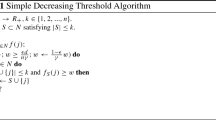Abstract
We study the problem of maximizing a monotone non-decreasing function \(f\) subject to a matroid constraint. Fisher, Nemhauser and Wolsey have shown that, if \(f\) is submodular, the greedy algorithm will find a solution with value at least \(\frac{1}{2}\) of the optimal value under a general matroid constraint and at least \(1-\frac{1}{e}\) of the optimal value under a uniform matroid \((\mathcal {M} = (X,\mathcal {I})\), \(\mathcal {I} = \{ S \subseteq X: |S| \le k\}\)) constraint. In this paper, we show that the greedy algorithm can find a solution with value at least \(\frac{1}{1+\mu }\) of the optimum value for a general monotone non-decreasing function with a general matroid constraint, where \(\mu = \alpha \), if \(0 \le \alpha \le 1\); \(\mu = \frac{\alpha ^K(1-\alpha ^K)}{K(1-\alpha )}\) if \(\alpha > 1\); here \(\alpha \) is a constant representing the “elemental curvature” of \(f\), and \(K\) is the cardinality of the largest maximal independent sets. We also show that the greedy algorithm can achieve a \(1 - (\frac{\alpha + \cdots + \alpha ^{k-1}}{1+\alpha + \cdots + \alpha ^{k-1}})^k\) approximation under a uniform matroid constraint. Under this unified \(\alpha \)-classification, submodular functions arise as the special case \(0 \le \alpha \le 1\).
Similar content being viewed by others
Notes
Given a set \(S \in \mathcal {I}\), return \(f(S)\).
Given an independence family \(\mathcal {I}\) and a set \(Y \subseteq X\), let \(\mathcal {B}(Y)\) be the set of maximal independent sets of \(\mathcal {I}\) included in \(Y\). Then \(\mathcal {I}\) is a \(p\)-system if, for all \(Y \subseteq X\), \(\frac{\max _{A \in \mathcal {B}(Y)} |A|}{\min _{A \in \mathcal {B}(Y)} |A|} \le p\). See the definition in Korte and Hausmann (1998) and Calinescu et al. (2011).
Given prices \(p_1,\ldots , p_n\), return a bundle \(S \in \arg \max _{T,T \subseteq X} f(T) - \sum _{i \in T} p_i\).
References
Ageev A, Sviridenko M (2004) Pipage rounding: a new method of constructing algorithms with proven performance guarantee. J Comb Optim 8(3):307–328
Alimonti P (1994) New local search approximation techniques for maximum generalized satisfiability problems. In: Proceedings of the 2nd Italian conference on algorithms and complexity, pp 40–53
Badanidiyuru A, Dobzinski S, Oren S (2011) Optimization with demand oracles. In: Proceedings of the 13th ACM conference on electronic commerce, pp 110–127
Buchbinder N, Feldman M, Naor J, Schwartz R (2012) A tight linear time \((1/2)\)-approximation for unconstrained submodular maximization. In: 53rd annual IEEE symposium on foundations of computer science
Calinescu G, Chekuri C, Pál M, Vondrák J (2011) Maximizing a submodular set function subject to a matroid constraint. SIAM J Comput 40(6):1740–1766
Chakrabarty D, Goel G (2008), On the approximability of budgeted allocations and improved lower bounds for submodular welfare maximization and GAP. In: Proceedings of the 49th annual IEEE symposium on foundations of computer science, pp 687–696
Chekuri C, Vondrák J, Zenklusen R (2011), Submodular function maximization via the multilinear relaxation and contention resolution schemes. In: Proceedings of the 43rd ACM symposium on theory of computing, pp 783–792
Conforti M, Cornuéjols G (1984) Submodular set functions, matroids and the greedy algorithm: tight worst-case bounds and some generalizations of the rado-edmonds theorem. Discrete Appl Math 7(3):251–274
Dobzinski S, Schapira M (2006) An improved approximation algorithm for combinatorial auctions with submodular bidders. In: Proceedings of the seventeenth annual ACM-SIAM symposium on discrete algorithm, pp 1064–1073
Feige U (1998) A threshold of ln n for approximation set cover. J ACM 45(4):634–652
Feige U, Vondrák J (2006), Approximation algorithms for allocation problems: improveing the factor of \(1-\frac{1}{e}\). In: Proceedings of 47th annual IEEE symposium on foundations of computer science, pp 667–676
Feige U, Vondrák J (1998) The submodular welfare problem with demand queries. Theory Comput 6:247–290
Filmus Y, Ward J (2012) A tight combinatorial algorithm for submodular maximization subject to a matroid constraint. In: Proceedings of 53rd annual IEEE symposium on foundations of computer science
Fisher ML, Nemhauser GL, Wolsey LA (1978) An analysis of approximations for maximizing submodular set functions - II. Math Progr Study 8:73–87
Kempe D, Kleinberg J, Tardos E (2005) Influential nodes in a diffusion model for social networks. In: Proceedings of 32nd international colloquium on automata, languages and programming, Lisboa, Portugal
Korte B, Hausmann D (1998) An analysis of the greedy heuritic for independence systems. Ann Discret Math 2:65–74
Kulik A, Shachnai H, Tamir T (2009) Maximizing submodular set functions subject to multiple linear constraints. In: Proceedings of the 20th annual ACM-SIAM symposium on discrete algorithms, pp 545–554
Lee J, Mirrokni V S, Nagarajan V, Sviridenko Maxim (2009) Non-monotone submodular maximization under matroid and knapsack constraints. In: Proceedings of the 41st annual ACM symposium on theory of computing, pp 323–332
Lee J, Sviridenko M, Vondrák (2010) Submodular maximization over multiple matroids via generalized exchange properties. Math Oper Res 35(4):795–806
Lloyd SP, Witsenhausen HS (1986) Weapons allocation is NP-complete. In: Proceedings of the 1986 summer conference on simulation, Reno
Lu J, Suda T (2003) Coverage-aware self-scheduling in sensor networks. In: Proceedings of IEEE 18th annual workshop on computer communications, Laguna Niguel
Nemhauser GL, Wolsey LA, Fisher ML (1978) An analysis of approximations for maximizing submodular set functions-I. Math Progr 14(1):265–294
Nembauser GL, Wolsey LA (1978) Best algorithms for approximating the maximum of a submodular set function. Math Oper Res 3(3):177–188
Sviridenko M (2004) A note on maximizing a submodular set function subject to a knapsack constraint. Oper Res Lett 32(1):41–43
Vondrák J (2008), Optimal approximation for the submodular welfare problem in the value oracle model. In: Proceedings of the 40th annual ACM symposium on theory of computing, pp 67–74
Vondrák J (2010) Submodularity and curvature: the optimal algorithm. RIMS Kokyuroku Bessatsu B23:253–266
Acknowledgments
This study was supported in part by the NSFC (No.61135001) and the AFOSR grant (FA2386-13-1-4080).
Author information
Authors and Affiliations
Corresponding author
Rights and permissions
About this article
Cite this article
Wang, Z., Moran, B., Wang, X. et al. Approximation for maximizing monotone non-decreasing set functions with a greedy method. J Comb Optim 31, 29–43 (2016). https://doi.org/10.1007/s10878-014-9707-3
Published:
Issue Date:
DOI: https://doi.org/10.1007/s10878-014-9707-3




